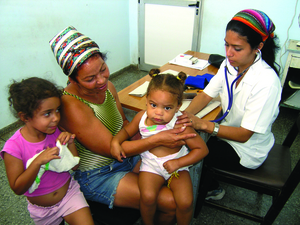Healthcare for all is not an aspiration but a reality for Cubans
Morning Star | Monday, 24 December 2018 | Click here for original article

"Visiiting Cuba reminds me that health for all is not a dream for the future, it's not just an aspiration; it’s a reality now. Cuba is an example for the world” - Tedros Adhanom Ghebreyesus, director-general, World Health Organisation
DESPITE the huge economic challenge of the US blockade, Cubans receive world leading healthcare. Health is enshrined in the constitution as a fundamental human right and delivered free of charge.
Although initially modelled on the NHS, it has since developed further, with a particular emphasis on prevention.
Before the revolution, Cuba had only three medical schools which were exclusively for wealthy Cubans. Today there are 23 medical schools training Cubans and overseas medics, free of charge – compared to over £70,000 to study medicine in England.
This has achieved one of the highest doctor-to-patient ratios in the world: over eight for every 1,000 citizens – more than double the rate in the US and in the UK.
The country has a similar life expectancy to the US and a lower infant mortality rate: 4:1,000 live births compared to 5.7. Women receive a minimum of 13 antenatal check-ups during pregnancy and maternity homes care for those with high-risk pregnancies or social problems.
Family doctors are the foundation of Cuba’s primary health care preventative model. Additionally, all sections of the health system and government departments co-operate and work together, rather than compete.
The emphasis is on the family doctor knowing each family, both medically and socially. This is extremely important in relation to child health where parents have a major influence on child health outcomes. Child mortality rates (neonatal, infant and under-five) are all lower in Cuba than in the US.
All Cuban families receive a minimum of an annual visit from the family doctor. As well as carrying out routine health checks such as blood pressure and heart checks, they also monitor lifestyle and other factors that can affect health. Higher risk families, for example, those with existing health conditions, or smokers, are seen more regularly.
The family doctor works in conjunction with a nurse from a small neighbourhood office – a “consultario” – where they also live in the community they serve.
For more specialist services, including adult medicine, paediatrics, obstetrics, gynaecology, dentistry and psychology, patients are referred to a polyclinic – which serves between 14 to 30 consultorios.
Patients see specialists quickly – usually waiting for one week –without needing to go to hospital. The primary care system ensures communication between the family doctor, the specialist and the patient.
Regional and specialist hospitals exist throughout the country for complex and tertiary care, but it is Cuba’s community-based primary healthcare provision which has produced impressive results.
In contrast to other developing countries, Cuba has an ageing population and health problems are similar to that of rich countries. The response to these new health challenges is huge investment in public health education around smoking, alcohol, diet and exercise – and the family doctor and nurse are key in delivering this message.
Cuba’s preventative model has made world leading achievements. If the Global South could replicate Cuba’s achievements, hundreds of millions of lives could be saved each year.
But the blockade prevents the island from obtaining crucial medical equipment, particularly in tertiary care, and US-produced medications. If the blockade was lifted, Cuba’s health achievements would be even more impressive.
This article, by Dr Imti Choonara and Ollie Hopkins, featured in the Morning Star special 60th Anniversary of the Cuban Revolution edition






